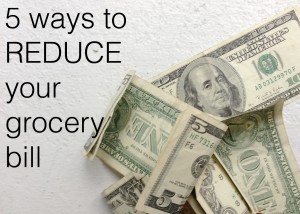————————————- ————————————-

Hi Beverly,
I hope things are going well. I haven’t been able to make it to one of your frugal grocery shopping seminars and was wondering if you will be teaching one again soon or could give me some pointers. I would like to do better in that area. I understand the basics of its cheaper to make from scratch than buy pre-made and I do that. Are there other things on top of that that I could do to reduce our grocery bill?
Thanks,
M—
————————————- ————————————-
Hi, M—,
Thanks for asking a great question! Yes, in addition to cooking from scratch, there are more things you can do to reduce your grocery bill.
1) Determine a set monthly food budget.
See the Official USDA Food Plans: Cost of Food at Home at Four Levels at http://www.cnpp.usda.gov to help you determine a reasonable budget. (Hint: I use the Thrifty Plan amount as my target budget.) Do not use leftover food money elsewhere just yet. Keep it to use in step #4 below.
2) Create a Master Shopping List.
A Master Shopping list (see the book “The Tightwad Gazette”) will help save you time and money by reducing what you might forget to purchase at the store on your shopping trip and by allowing you to see quickly which store has the best price on the item you want. Try to stay $20 under the total of what you planned to spend. Keep the used Master Shopping lists for future reference in making a Price Book (I can explain that later.)
3) Compare unit prices to determine lowest actual costs.
Always have a calculator with you when you go to the store. Compare the unit price (i.e. the actual price per pound or ounce) between items—as opposed to relying on the sale sign—to determine which item is the best buy. Do not believe the sale sign or automatically assume that buying in bulk will be cheaper. Use your calculator to run the numbers and prove which item is less expensive. Sometimes smaller packages of an item are actually less expensive per ounce than the larger packages.
4) Build up your pantry by using leftover food money to stock up on sale items.
These are often “loss leaders” you see in the grocery ads. In other words, merchants willingly take a loss of profit on a few items hoping to lead you into the store where you will no doubt impulsively buy other items, allowing them to recoup their losses and actually make a profit.
5) Only stock up on sale items that you actually use. Wasted food is wasted money. Buy what you use and use what you buy.
Caution: Be careful with couponing. It’s great to use coupons to buy items you actually use, but many coupons are for unhealthy or frivolous foods. Your food budget should be used to buy the best health you can for your family, too. It’s not frugal if you try to save pennies in the store and wind up spending dollars in the doctor office because your family has been eating junk food purchased with coupons. Be wise. Be aware of how all your choices link together to affect your overall household budget.
Eventually your pantry will consist mostly of sale items and the bulk of your purchases will be sale items—Now your monthly food budget can be reduced and the extra money can be used to pay down debt or etc. If I were you, however, I would save that money until I had enough to buy a decent freezer—which is another kind of pantry to fill up that can also save you time, energy and money.
